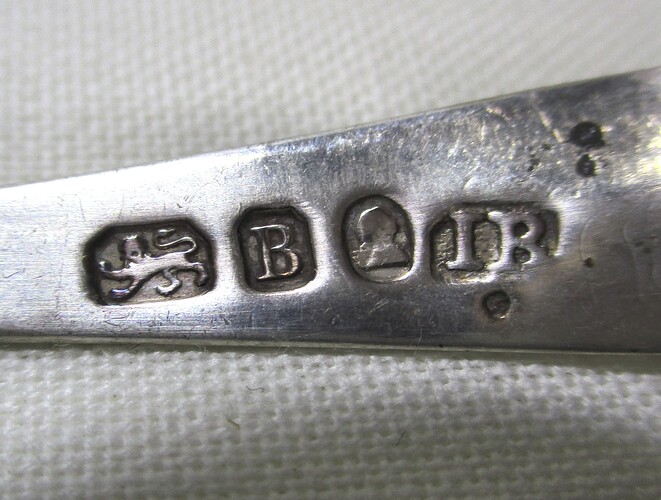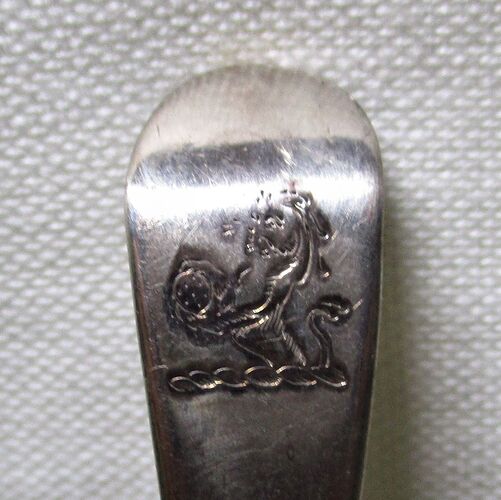I’m hoping that someone can help me identify the hallmarks on this mustard ladle. I’m aware that the assay mark was not always included on pieces of this size and weight (9.3g), so my best guess is London. I think the duty mark is George III and the date letter possibly 1797. No idea as to the maker’s mark or if there is any meaning to the design on the top of the stem (looks like a lion holding a ball). I don’t often handle silver of this age, so any insight would be appreciated.
I can confirm that this is a London hallmark and that the assay date is 1797/98. There are several candidates for the IB mark all of whom had very similar marks:
-
John Blake, smallworker & spoonmaker (registered Sep 1788 & May 1803)
-
James Beattie, smallworker (registered Jul 1790)
-
John Boyer, smallworker (registered Jun 1794)
-
Joseph Barnard, smallworker (registered Feb 1798)
If I was forced to pick just one it would be John Blake as he was clearly working for a reasonable period and he professed to be a spoonmaker.
The device on the handle is a family armorial and identifes the owner. You may be able to find the design and thereby derive a list of possible family names by searching through “Fairbairn’s Crests”, several editions of which are available online.
Phil
Hi Phil,
Many thanks for your help. Having looked up spoons attributed to John Blake, including one just two years newer, I think there’s a very good chance he was the maker. I am grateful to you for confirming that it is a London hallmark from 1797/8.
As for the family name, I appear to have stumbled on the answer with your help. I am going to do a little more research because a part of me thinks it cannot be so obvious, but it seems the family crest depicting a lion holding a ball may be that of the Ball family.
Rob
Punning armorials are not uncommon!
So Rob, now you have identified the maker and done the research on the armorial what are you going to do with these tongs?
I only ask as I have a drawer full of them and cannot figure out a use, lump sugar having gone the way of the dodo bird.
As you will probably know when the slave owners of Barbados and other Caribbean islands including the royals upset the Americans by imposing a 4% stamp duty on American sugar but not imposing it on their island colonies the sugar arrived in the homes of the well to do in huge lumps which needed to be hammered down into small lumps which were then deposited in tea or coffee or chocolate drinks and stored in sugar baskets.
The debris from all this was collected into castors which were then used to sprinkle it on fruit or anything else the sometimes unreliable UK sun had failed to render sweet enough. Two types of casters existed – the domed containers which were also used for condiments in a smaller version and the modified ladles with holes in.
Since we have now decided sugar is responsible for more deaths in the modern sweet addicted diabetic-prone world than even its 18th century harvest by forced or slave labor achieved, all these pretty instruments including your fine tongs are looking for a new purpose.
The old joke about the young bride, puzzled by them as a wedding gift, hanging them in the gents cloakroom probably isn’t based on any forensic evidence and might be rather uncomfortable anyway so something else.
I suppose bracelets would be pssible but it requires refashioning rather than re-purposing.
They are somewhat useful for extracting olives from that rather unpleasant brine some packers still use. But one can only consume so many dirty martinis before tongs are rendered redundant anyway.
There is a small parish with a large church called Tong in Shropshire in your country. Perhaps if they had a mayor his chain of office could be made of interlocking pairs. But I think we would have to create the mayor before the tongs could be employed to purpose.
Any thoughts?
Christopher
Hi Christopher,
I haven’t decided what I will do with the spoon yet. I bought it in an auction lot of “white metal” that turned out to be all hallmarked silver except for one pair of silver plated vases by Mappin and Webb. I paid £45 plus commission for the lot and have so far sold the pieces for £420 with a couple left to go, so I may keep the spoon for my collection. Otherwise, I would list a spoon of this age at between £50 and £75 on ebay and could reasonably expect a sale in the £40-£60 range.
I’m not a fan of jewellery made from converted cutlery. In my experience, the jewellery doesn’t seem to sell for any more or sell any faster than the pieces in their original form, unless we’re talking a bland teaspoon that isn’t part of a set. People still buy sugar tongs - I sell 6-8 pairs of silver plated tongs every year in the £10-£20 range. Not a lot of money, but worth it as I tend to pick them up for £1-£2.
When it comes to sterling silver cutlery, if the quality is good I sell the pieces on their own - they take a while to go, but they get there in the end. If the quality is not so good, I hold onto them until I have 5-6 pieces and put them into auction as a single lot. The return is not fantastic, but it’s usually a good deal over the scrap value of the silver.
I would never even consider scrapping a piece of silver of this age - a lot of pre-Victorian silver was melted down during Victoria’s reign, so there isn’t a mass quantity of it around. I have been buying and selling silver (and antiques) for just over 15 years and have only handled four pieces made before 1837. Pride of place in my collection is a dish hallmarked London 1571 and beside it a William Ellerby spoon hallmarked 1812. I sold one other piece from 1775 and have yet to decide about the ladle.
I would never scrap or repurpose, or knowingly sell to someone who intends to scrap or repurpose, a piece of silver that is more than 200 years old. If it’s Victorian or later, it depends on the quality and condition, but I generally sell them as they are. The only pieces I’ve struggled to sell are a pair of sterling silver Edwardian salts - I’ve had them now for 4 years and will sadly have to scrap them if they don’t sell by the end of the year.
Rob

